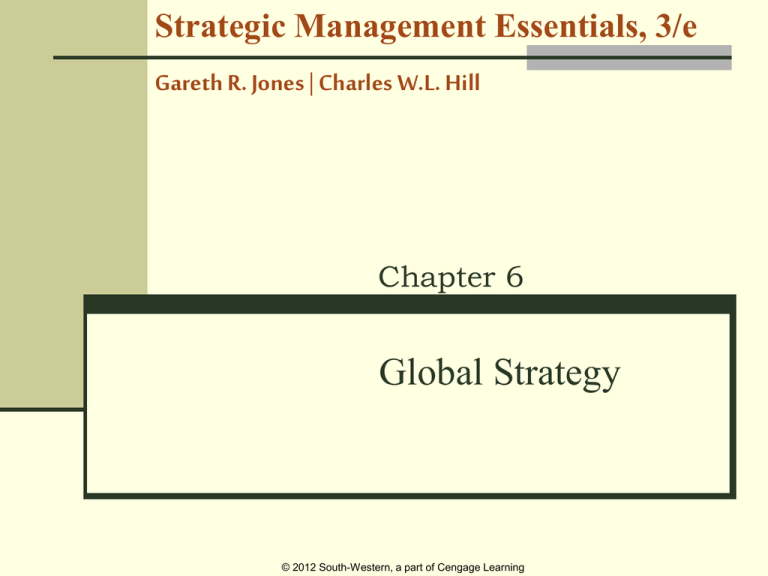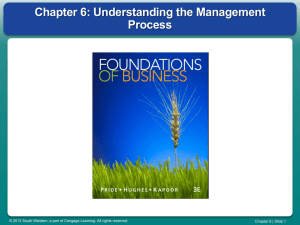111152520X_303814
advertisement

Strategic Management Essentials, 3/e Gareth R. Jones | Charles W.L. Hill Chapter 6 Global Strategy © 2012 South-Western, a part of Cengage Learning The Global Environment Managers need to consider: – – – How globalization is impacting the environment in which their company competes What strategies they should adopt to exploit opportunities How to counter competitive threats © 2012 South-Western, a part of Cengage Learning The Global Environment Industry boundaries do not stop at national borders The shift to global markets has intensified competitive rivalry in industries Global markets created enormous opportunities © 2012 South-Western, a part of Cengage Learning Increasing Profitability Through Globalization The success of many multinational companies is based not just on the goods and services they sell, but upon the distinctive competencies that underlie their production and marketing Globalization increases profits by: – – – – Expanding the market Realizing economies of scale Realizing location economies Leveraging the skills of global subsidiaries © 2012 South-Western, a part of Cengage Learning Competitive Pressures Two main pressures: Pressure for cost reduction Pressure to be locally responsive These pressures place conflicting demands on a company © 2012 South-Western, a part of Cengage Learning Cost Reductions Cost reductions are common in: – – – Industries where price is the main competitive weapon Industries with universal need products Universal Need: When consumer preference is similar or identical in different nations Companies may achieve cost reduction by basing production in a low-cost location or by offering a standardized product. © 2012 South-Western, a part of Cengage Learning Local Responsiveness Pressures These arise from differences in: – – – – Consumer taste and preferences Infrastructure or traditional practices Distribution channels Host government demands The more that customer preferences vary, the more local responsiveness is required © 2012 South-Western, a part of Cengage Learning Choosing a Strategy Basic four strategies: Global Standardization Strategy Localization Strategy Transnational Strategy International Strategy © 2012 South-Western, a part of Cengage Learning Global Standardization Strategy Focuses on increasing profitability by pursuing a low-cost strategy on a global scale Works best if there is: – – Strong pressure for cost reduction Low pressure for local responsiveness © 2012 South-Western, a part of Cengage Learning Localization Strategy Customizes goods or services to provide a good match to tastes and preferences in different national markets Works best if there is: – – Low cost pressure Varied taste and preferences by nation © 2012 South-Western, a part of Cengage Learning Transnational Strategy Attempts to achieve low-cost, differentiated products across markets and to foster a flow of skills between different subsidiaries Works best if there is simultaneous : – – High cost pressures High local responsiveness pressures © 2012 South-Western, a part of Cengage Learning International Strategy Centralizes product development, but manufactures and markets globally Works best if there is: – – – – Low cost pressure Low pressure for local responsiveness A universal need product No significant competitors © 2012 South-Western, a part of Cengage Learning Choices of Entry Mode Exporting – – – Many companies begin global expansion through exporting production Exporting allows companies to bypass the cost of establishing manufacturing facilities Exporting may be consistent with scale economies and location economies © 2012 South-Western, a part of Cengage Learning Choices of Entry Mode (cont’d) Licensing – – A licensee in a foreign country can purchase the rights to produce a product in their country The cost of development is low, as well as the risk involved © 2012 South-Western, a part of Cengage Learning Choices of Entry Mode (cont’d) Franchising A specialized form of licensing where the franchiser sells intangible property (usually a brand or trademark). The franchisee agrees to follow the strict rules and business plans of the company © 2012 South-Western, a part of Cengage Learning Choices of Entry Mode (cont’d) Joint Venture – – – Separate corporations come together to form a new corporate entity Two or more companies have an ownership stake, but combine resources for mutual benefit Sharing knowledge can be dangerous for the companies involved © 2012 South-Western, a part of Cengage Learning Choices of Entry Mode (cont’d) Wholly Owned Subsidiaries – – A parent company owns 100% of a smaller self-contained business unit This can be a very costly approach, since the parent company is responsible for all of the financing © 2012 South-Western, a part of Cengage Learning




